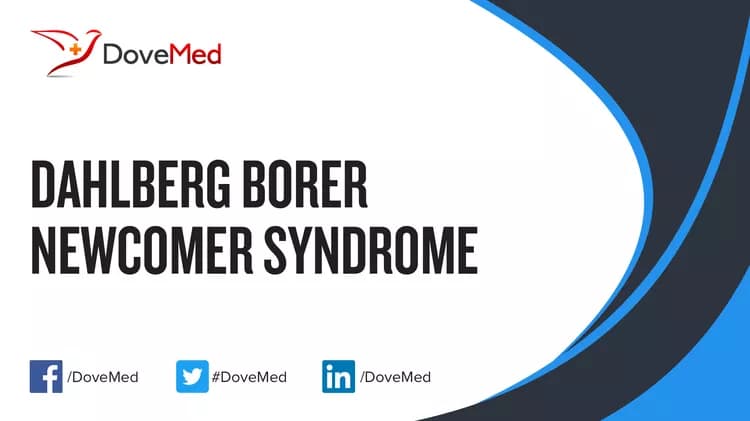What are the other Names for this Condition? (Also known as/Synonyms)
- Lymphedema-Hypoparathyroidism Syndrome
What is Dahlberg-Borer-Newcomer Syndrome? (Definition/Background Information)
- Dahlberg-Borer-Newcomer Syndrome is a very rare ectodermal dysplasia syndrome, described in 2 adult brothers, characterized by the association of hypoparathyroidism, nephropathy, congenital lymphedema, mitral valve prolapse and brachytelephalangy
- Additional features include mild facial dysmorphism, hypertrichosis, and nail abnormalities
(Source: Dahlberg-Borer-Newcomer Syndrome;Orphanet, National Institute of Health and Medical Research (INSERM), Paris.)
Who gets Dahlberg-Borer-Newcomer Syndrome? (Age and Sex Distribution)
- Dahlberg-Borer-Newcomer Syndrome is an extremely rare congenital disorder. The presentation of symptoms may occur at or following birth
- Both males and females may be affected
- Worldwide, individuals of all racial and ethnic groups may be affected
What are the Risk Factors for Dahlberg-Borer-Newcomer Syndrome? (Predisposing Factors)
- Currently, no risk factors have been clearly identified for Dahlberg-Borer-Newcomer Syndrome
It is important to note that having a risk factor does not mean that one will get the condition. A risk factor increases one’s chances of getting a condition compared to an individual without the risk factors. Some risk factors are more important than others.
Also, not having a risk factor does not mean that an individual will not get the condition. It is always important to discuss the effect of risk factors with your healthcare provider.
What are the Causes of Dahlberg-Borer-Newcomer Syndrome? (Etiology)
- The exact cause of Dahlberg-Borer-Newcomer Syndrome is presently unknown. However, it is reportedly a form of ectodermal dysplasia syndrome (which is a group of genetic disorders).
- Dahlberg-Borer-Newcomer Syndrome may either be inherited as an autosomal or X-linked recessive disorder
Autosomal recessive pattern of inheritance: Autosomal recessive conditions are traits or disorders that occur when two copies of an abnormal gene have been inherited on a non-sex chromosome. If both parents have an autosomal recessive condition, there is a 100% likelihood of passing on the mutated genes to their children. If, however, only one mutant copy of the gene is inherited, the individual will be a carrier of the condition, but will not be present with any symptoms. Children born to two carriers, have a 25% chance of being homozygous dominant (unaffected), a 50% chance of being heterozygous (carrier), and a 25% chance of being homozygous recessive (affected).
X-linked recessive pattern of inheritance: The gene associated with this condition may be located on the X chromosome, which is one of the two sex chromosomes. In males (who have only one X chromosome), one altered copy of the gene in each cell is sufficient to cause the condition. In females (who have two X chromosomes), a mutation would have to occur in both copies of the gene to cause the disorder. Because it is unlikely that females will have two altered copies of this gene, males are affected by X-linked recessive disorders much more frequently than females. A characteristic of X-linked inheritance is that fathers cannot pass X-linked traits to their sons.
What are the Signs and Symptoms of Dahlberg-Borer-Newcomer Syndrome?
The signs and symptoms of Dahlberg-Borer-Newcomer Syndrome may include:
- Hypertrichosis
- Increased carrying angle
- Ptosis
- Pulmonary lymphangiectasia
- Restrictive ventilatory defect
Very frequently present symptoms in 80-99% of the cases:
Frequently present symptoms in 30-79% of the cases: Cataract
Occasionally present symptoms in 5-29% of the cases: Renal insufficiency
(Source: Dahlberg-Borer-Newcomer Syndrome;Genetic and Rare Diseases Information Center (GARD) of National Center for Advancing Translational Sciences (NCATS), USA.)
How is Dahlberg-Borer-Newcomer Syndrome Diagnosed?
Dahlberg-Borer-Newcomer Syndrome is diagnosed on the basis of the following information:
- Complete physical examination
- Thorough medical history evaluation
- Assessment of signs and symptoms
- Laboratory tests
- Imaging studies
- Biopsy studies, if necessary
Many clinical conditions may have similar signs and symptoms. Your healthcare provider may perform additional tests to rule out other clinical conditions to arrive at a definitive diagnosis.
What are the possible Complications of Dahlberg-Borer-Newcomer Syndrome?
The complications of Dahlberg-Borer-Newcomer Syndrome may include:
- Respiratory distress
- Facial deformity
- Severe thyroid abnormalities
- Heart abnormalities
Complications may occur with or without treatment, and in some cases, due to treatment also.
How is Dahlberg-Borer-Newcomer Syndrome Treated?
There is no cure for Dahlberg-Borer-Newcomer Syndrome, since it is a genetic condition. The treatment is usually given to manage the signs and symptoms and any complications that develop.
How can Dahlberg-Borer-Newcomer Syndrome be Prevented?
Currently, Dahlberg-Borer-Newcomer Syndrome may not be preventable, since it is a genetic disorder.
- If there is a family history of the condition, then genetic counseling will help assess risks, before planning for a child
- Active research is currently being performed to explore the possibilities for treatment and prevention of inherited and acquired genetic disorders
Regular medical screening at periodic intervals with tests and physical examinations are recommended.
What is the Prognosis of Dahlberg-Borer-Newcomer Syndrome? (Outcomes/Resolutions)
- The prognosis of Dahlberg-Borer-Newcomer Syndrome is dependent upon the severity of the signs and symptoms and associated complications, if any
- Individuals with mild conditions have better prognosis than those with severe symptoms and complications
- Typically, the prognosis may be assessed on a case-by-case basis
Additional and Relevant Useful Information for Dahlberg-Borer-Newcomer Syndrome:
The following DoveMed website link is a useful resource for additional information:
Related Articles
Test Your Knowledge
Asked by users
Related Centers
Related Specialties
Related Physicians
Related Procedures
Related Resources
Join DoveHubs
and connect with fellow professionals


0 Comments
Please log in to post a comment.